Nine Innings: Figuring Out Luis Severino, the Best Pitch in Baseball and How the Red Sox Exposed the Yankees

WHAT HAS HAPPENED TO LUIS SEVERINO?
By Tom Verducci
While Yankees starter Luis Severino threw the ball better in Friday's loss than he had in his previous four starts, he still is nagged by a problem that must concern the team: he can’t command his fastball down and away. The home run he gave up to Steve Pearce was one of many four-seam fastballs he has thrown recently that were meant to be down and away but are pouring down the middle of the plate.
His velocity and spin rate have remained fairly consistent, but fastball command has made him much more hittable:
Batters vs. Severino's Fastball
| Batting Average | Home Runs |
|---|---|---|
Before July 7 | .214 | 3 |
Since July 7 | .397* | 4 |
*Third worst in MLB (1. Jeremy Hellickson; 2. Mike Montgomery)
Severino has looked at video and found nothing mechanically wrong, and though the Yankees believe his stuff “is down a tick,” it’s still plenty good enough to dominate.
One other area Severino might want to explore is the possibility of tipping his pitches. One team earlier this season saw a small tip in the way Severino positioned his glove during his arm swing, but it was too close to his release point for a hitter to act on it. (Hitters cannot change focus from glove to release point that late in the delivery.)
More recently, a team found a clue in Severino’s plant foot—and only during his windup—but found the giveaway didn’t happen often enough (about 60%) on which to bank.
But when I looked for it live Friday night from field level, it was there almost 90% of the time. After Severino plants his right foot against the rubber in his windup, when he throws his slider he raises his heel higher than when he throws a fastball. A tip early in the delivery like that gives a hitter enough time to re-focus on release.
I saw no sign the Red Sox were changing focus, and three Red Sox sources told me emphatically after the game they did not have Severino’s pitches. Results were mixed. Severino threw 85 pitches out of the windup Friday and obtained only five swings and misses, but also Boston hit only .250 on those pitches (4-for-16).
But the Yankees ought to be worried that something is going on with Severino out of the windup, especially with his fastball command. Look at how his season has cratered in the past month when pitching out of the windup:
Severino With Bases Empty
| Batting Average | Slugging Percentage |
|---|---|---|
Before July 7 | .181 | .251 |
After July 7 | .406 | .703 |
That rise in slugging percentage is alarming. Since July 7 Severino has given up more hits with the bases empty (26) than any pitcher in baseball. Here is a guy with a 97 mph fastball and a wipeout slider—and fully healthy—and he is the worst pitcher in baseball out of the windup for the past month, and by a lot:
Highest Batting Average With Bases Empty Since July 7
Pitcher | Batting Average |
|---|---|
1. Luis Severino, Yankees | .406 |
2. Jordan Zimmermann, Tigers | .377 |
3. Kevin Gausman, Braves | .339 |
4. Ivan Nova, Pirates | .317 |
EMPTYING THE NOTEBOOK: RED SOX EXPOSE CC SABATHIA, THE YANKEES' TWO-STRIKE WOES
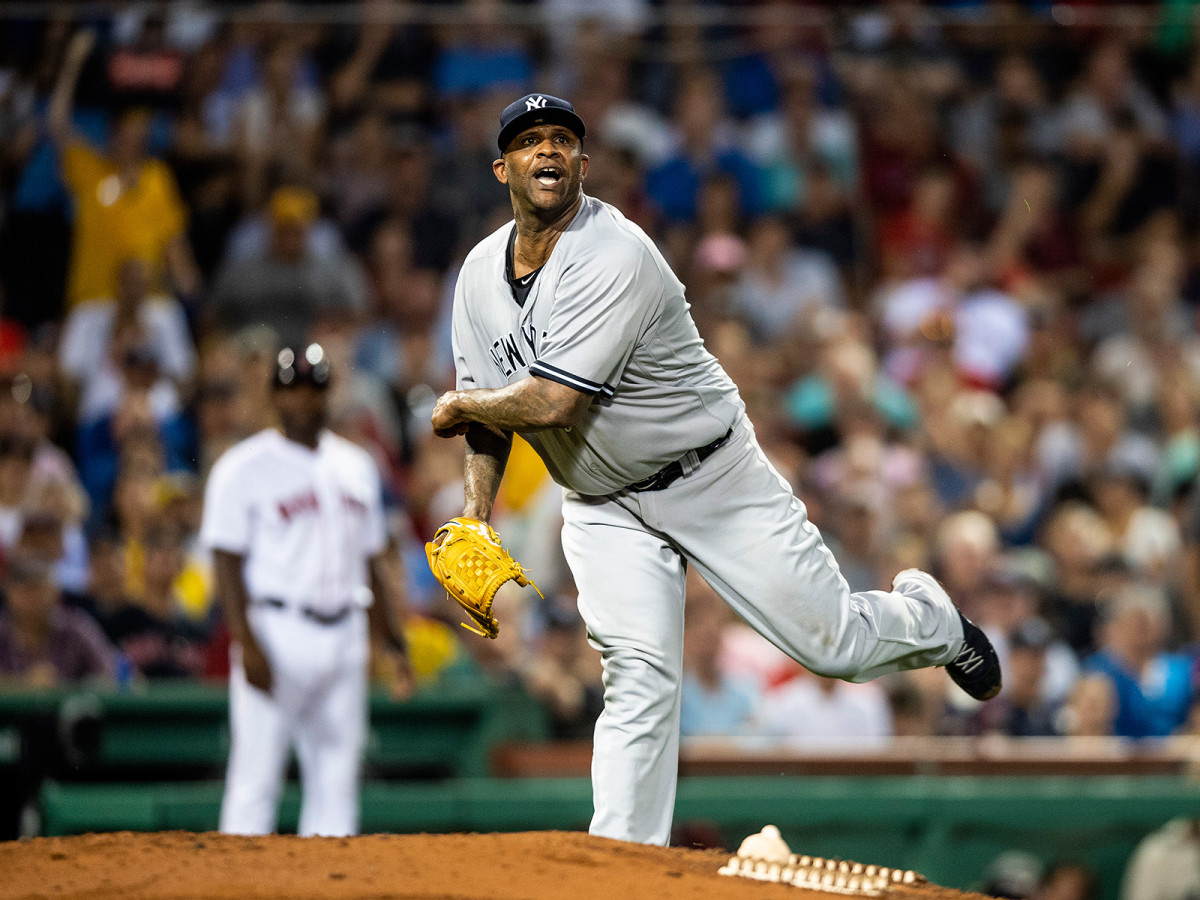
By Tom Verducci
Boston didn’t just win the series, it also exposed CC Sabathia. Before the series opener, one of the Red Sox said, “We’re going to run. Oh, yeah. We’ll run.” The Red Sox’ scouting information shared in the pregame meeting that Sabathia made a pickoff attempt to first base only four times all year, including three times back in May against Texas.
Sabathia did make one pickoff attempt Thursday night, but it was an ugly, lollipop throw to first—not quite as bad as when he threw away a ball hit back to the box. Sabathia hasn’t picked off a runner in five years. He clearly is not comfortable throwing to first, preferring to defend runners by varying his holds and slide-stepping.
So the emboldened Red Sox ran on first move—taking off as soon as Sabathia lifted his front foot because the overwhelming odds were that he would not throw to first base.
The Red Sox swiped two bases off Sabathia. Basestealers are 11-for-12 against him since May 10.
Boston added two more steals off a frazzled Jonathan Holder. All four steals happened on a first or second pitch, which makes the lapse of Severino the next night inexcusable.
Ian Kinsler was the first Boston batter to reach first base, in the first inning with two outs. You would think after the track meet the night before that the Yankees and Severino would be prepared to defend the running game. They were not. With Severino paying no attention, Kinsler, from a walking lead, took off for second on the first pitch and stole it easily. He scored on a two-out single by Eduardo Nunez.
The Yankees lost 4-1 in which they gave away two runs with a lack of focus: Severino not holding the runner, and later Gleyber Torres failing to stop a routine groundball with a runner at second.
***
The Red Sox this weekend outclassed a Yankees team without Gary Sanchez and Aaron Judge. What stands out is how Boston not only is the better team right now, but also looks like the better team when it comes to playing the kind of baseball that wins in October.
In taking the first three games of the series, the Red Sox hit .204 with two strikes, whiffing just 15 times. The Yankees hit .102 with two strikes, whiffing 28 times.
The pattern has held throughout the season. Boston is the best two-strike hitting team in baseball entering Sunday, at .203. The Yankees rank 20th at .172.
How much does that matter in October? As strikeouts keep rising at record rates, the teams that can put the ball in play in October rather than piling up empty outs—especially when the quality of pitching increases—gain an advantage.
Houston, for instance, addressed that very concept with its club last year. Tired of what manager A.J. Hinch called “too many empty at-bats,” the Astros tweaked their roster and went from racking up the fourth-most strikeouts in baseball in 2016 to the fewest in 2017—and won the world championship. In the postseason last year the Astros were +39 in strikeout differential. This year the Astros are a whopping +339 – which means they have more productive outs and have to defend fewer balls in play. Boston is an impressive +224. New York is +102.
Only one of the past seven world champions ranked below sixth in the majors in two-strike hitting:
Ranking of Two-Strike Hitting, World Series Champions 2011-17
Team | MLB Rank |
|---|---|
2017 Astros | 1 |
2016 Cubs | 6 |
2015 Royals | T1 |
2014 Giants | T9 |
2013 Red Sox | 2 |
2012 Giants | T5 |
2011 Cardinals | T4 |
So the Yankees have their work cut out to win a title with such poor two-strike hitting. Since 1988, when such records have been tracked, only two world champions hit worse with two strikes than the Yankees’ current mark of .172: the 1995 Braves (.164 in a strike-shortened season) and the 1988 Dodgers (.171). Both occurred before baseball’s big strikeout boom.
LUIS SEVERINO'S ERRANT MESSAGE PITCH AND RICK PORCELLO'S RARE DOMINANCE
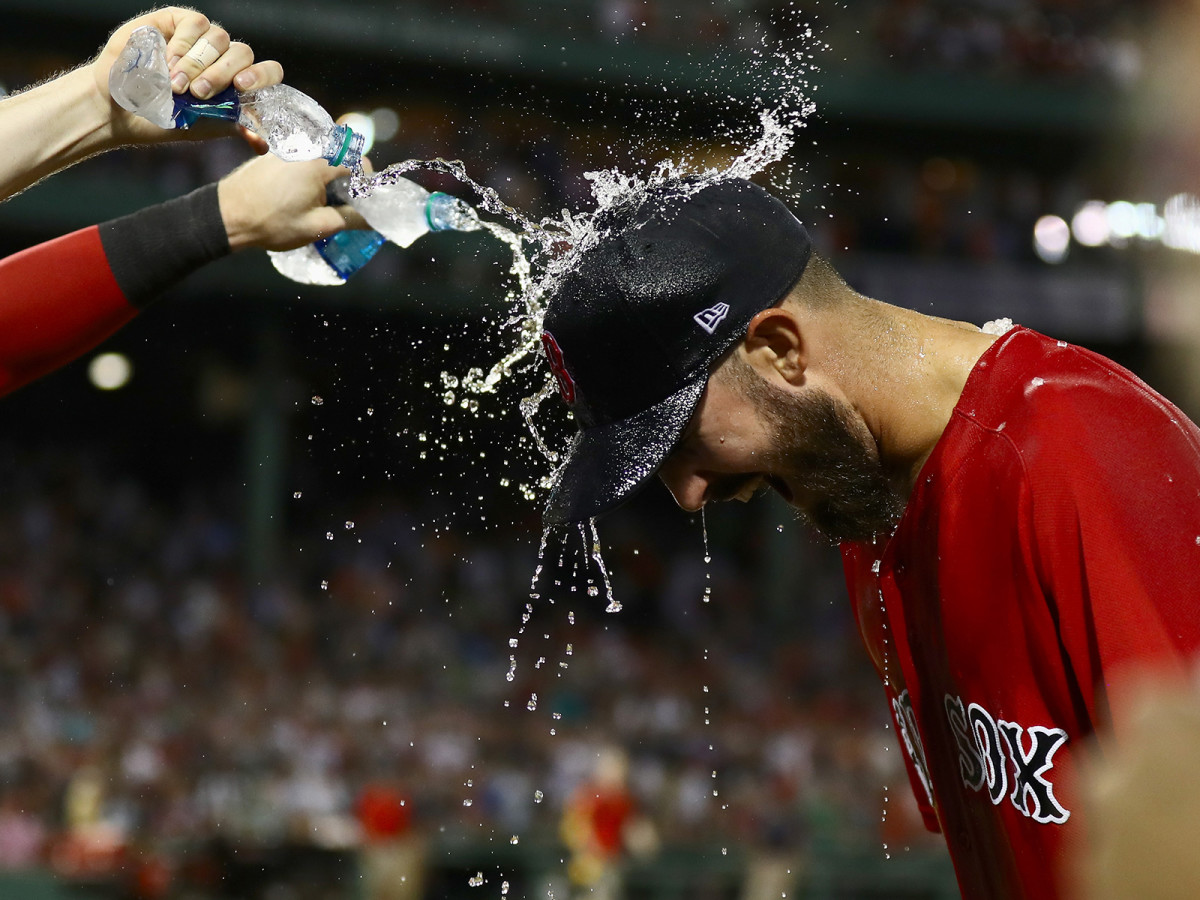
By Tom Verducci
Crew Chief Phil Cuzzi, working first base, was absolutely correct to nudge home plate umpire Adam Hamari into issuing warnings to both teams after Luis Severino threw his first pitch Friday near the head of Mookie Betts. Only the night before, Boston hitters looked extremely comfortable in the box swatting 10 extra-base hits against the Yankees—for only the third time in the history of the rivalry. Then Boston starter Rick Porcello nicked New York leadoff batter Brett Gardner with an 0-2 pitch to start the Friday game.
The Yankees were getting pushed around and it was time for Severino to send a message. Don’t buy the “I was just trying to pitch inside” cover story from a guy with great control, which is de rigueur for avoiding a fine.
Here’s proof he was sending a message: Severino has thrown 7,664 pitches in his career. Only two of them have been head high and inside the righthanded batter’s box to a righthanded hitter, and both were deemed intentional by umpires:
1. Oct. 10, 2015: a 94.1 mph fastball at the head of Paul Janish of the Orioles—after two Yankees had been hit by Baltimore pitchers—that drew a warning from home plate umpire Mike Muchlinski.
2. Aug. 3, 2018: the 95.6 mph fastball at the head of Betts—which also drew a warning.
Severino just doesn’t accidentally lose fastballs up and in to righthanded hitters like that. And if he’s going to send messages, he better learn not to deliver his messages at a batter’s head.
Boston manager Alex Cora was incensed because he figured for the umpires to issue a warning they must have deciphered intent on Severino’s part. And, Cora reasoned, if they read intent then they should have ejected Severino for throwing at Betts. (Umpires can eject players without a warning.)
Of course, Boston couldn’t just sit there and let Severino take a free shot at their best hitter, spinning him around and on his rump. Retaliation protocol calls for their pitcher to go after the best players in the other lineup (Giancarlo Stanton), but only when their pitcher is close to coming out of the game—say, around 100 pitches—so as not to put the game and bullpen in jeopardy.
In this case, Porcello was so good that he didn’t get close to 100 pitches. He needed only 86 pitches for a complete game. Protocol fell to the next day’s starter, Nathan Eovaldi, who threw one behind Stanton.
How good was Porcello? Nobody alive had ever seen a Red Sox pitcher dominate the Yankees at Fenway like that. It was once-a-century stuff:
Red Sox Pitchers to One- or No-Hit Yankees at Fenway Park
| Date | Hits |
|---|---|---|
Smoky Joe Wood | June 29, 1912 | 1 (Seven innings) |
Rube Foster | June 21, 1916 | 0 |
Rick Porcello | August 3, 2018 | 1 |
ROUNDTABLE: WHAT IS THE BEST PITCH IN BASEBALL TODAY?
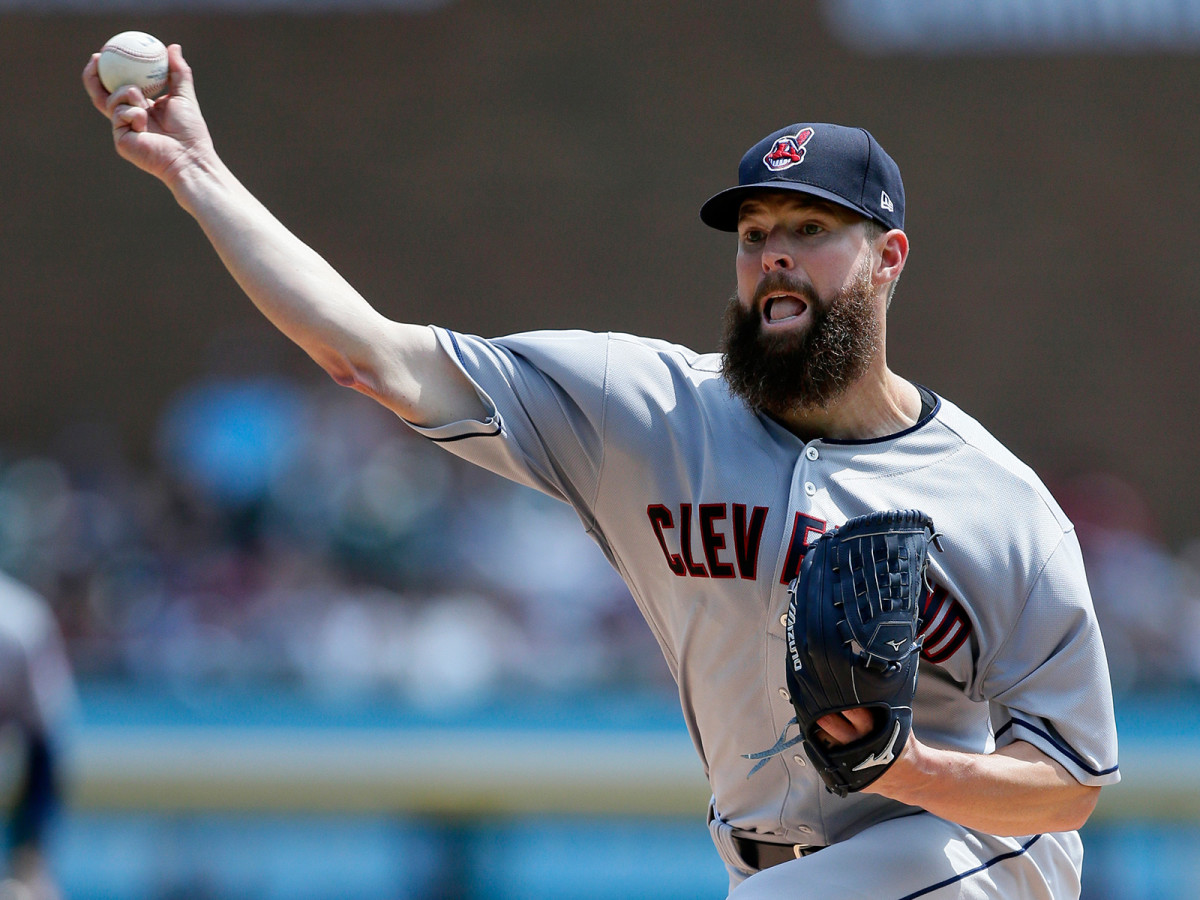
Emma Baccellieri: Corey Kluber’s breaking ball. Is it a slider? A curve? Doesn’t matter what you call it, the pitch is filthy. Since 2016, there are only three pitchers with a higher strikeout-to-walk ratio than Kluber, and he earns more whiffs on the breaking ball than on anything else. It’s his putaway pitch—he goes to it on two-strike counts more readily than any other pitch in his arsenal—and it not only works, it looks nasty in the process.
48 Seconds of Corey Kluber's Sliders (one game). 😷 pic.twitter.com/jwuEYkzKcw
— Rob Friedman (@PitchingNinja) February 8, 2018
Michael Beller: I’m not interested in defining this one with exact statistics. I want the pitch that makes me guffaw involuntarily when I see it. No pitch type is better at eliciting that reaction than a two-seam fastball that darts back across the corner of the plate at the last second, well after the hitter has given up on it. No pitcher is better at that than Trevor Bauer. Especially to get strike three.
Bauer has 195 strikeouts this season. Twenty-five of those have come with a called third two-seamer. That’s nearly 13% of his strikeouts not only with the same pitch, but with it for a called strike.
Here he is owning Matt Carpenter with it:
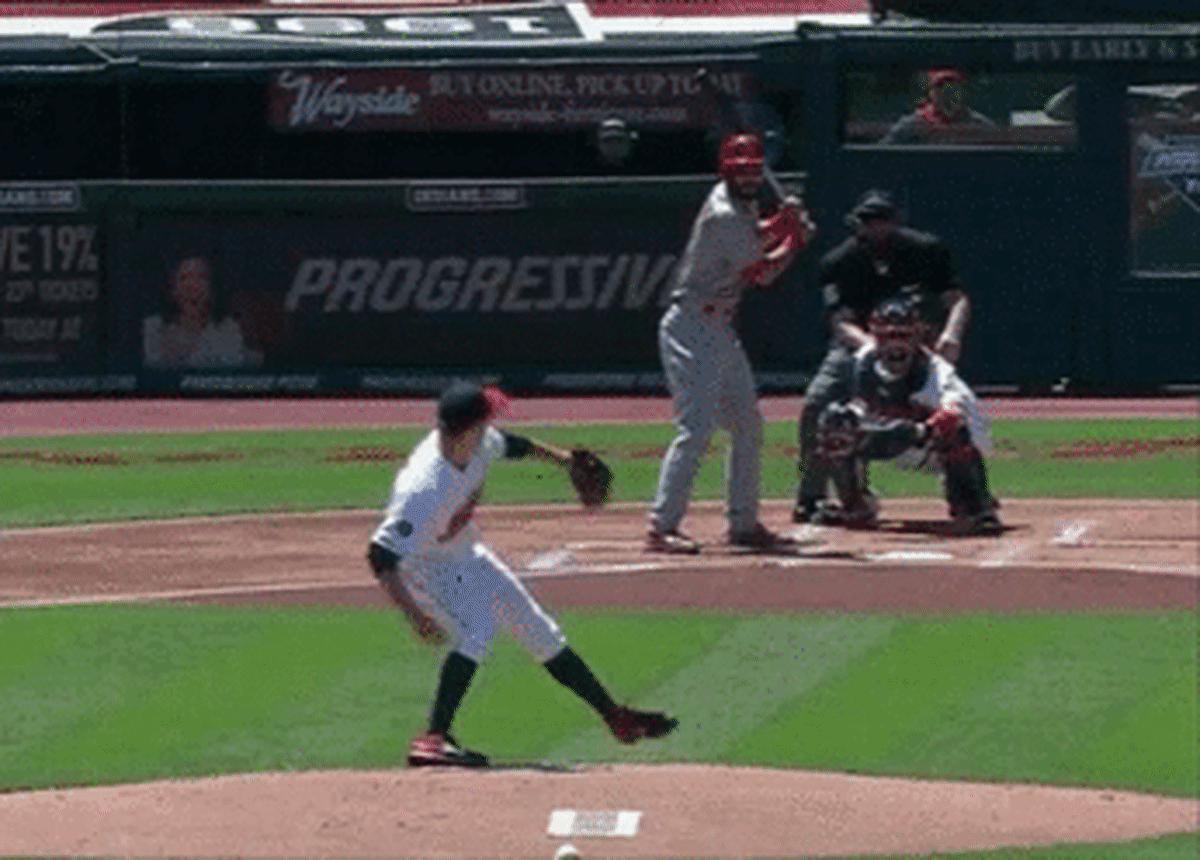
Bauer has an electric arsenal, and this isn’t just one of his best pitches. It’s one of the very best in baseball.
Connor Grossman:
Pablo Sandoval, Filthy Two Pitch Sequence (87mph Fastball and 70mph Curveball). 🐼🔥
— Rob Friedman (@PitchingNinja) April 29, 2018
[H/T @KeithOlbermann ] pic.twitter.com/6FQY6RRPts
Jon Tayler: Instead of words describing it, I should just embed all the best GIFs of Adam Ottavino’s ridiculous, slicing, roller-coaster slider. But then we’d have like 200 tweets in a row, and that can’t be a fun user experience. So let’s just pick a few.
Adam Ottavino, Disgusting 82 mph Slider. 🤮 pic.twitter.com/q5GV9Zsm5A
— Rob Friedman (@PitchingNinja) April 22, 2018
Adam Ottavino, Ridiculous 82mph Slider. 😱
— Rob Friedman (@PitchingNinja) May 2, 2018
One of these days a slider is going to go around the batter and hit Ottavino in the back of the head. pic.twitter.com/uL4neB4jVv
Adam Ottavino, Filthy 82mph Slider. 🤢
— Rob Friedman (@PitchingNinja) May 6, 2018
Brandon Nimmo with the O face.** 😮
**The involuntary look when you see Ottavino's Slider. pic.twitter.com/S1N0Ysgo55
Brandon Nimmo’s face in that last GIF is the reaction of a man suddenly and instantly presented with all the truths of the universe, causing his cerebellum to crumble into dust and dreams. Ottavino’s slider walked up to Nimmo on the street, calmly whispered the time and place of his death into his ear, and then left without another word. It’s jaw-dropping—the baseball equivalent of the twist at the end of The Usual Suspects. It’s fun and baffling, and it’s a big reason why Ottavino—he of the 1.35 ERA and 78 strikeouts in 53 1/3 innings—has been the only saving grace of the Rockies’ oily rag of a bullpen. Treat yourself and go watch those GIFs a few more times.
Tom Verducci: Because of its sweeping break and because of the extreme offset of his release point (three feet from the center of the rubber), the slider of Chris Sale is the nastiest pitch in baseball. Want proof?
• Batters are hitting .102 against Sale’s slider.
• He has thrown the pitch 775 times—and given up just 18 hits, including just one home run (by Justin Smoak).
• The pitch is at its nastiest when Sale buries it down and in to righthanded batters. It is virtually unhittable. Sale has thrown 114 sliders down and in to righthanded batters and allowed only one hit—a single by Adrian Beltre July 11. Until then, righthanded hitters had been 0-for-21 this year against Sale’s down-and-in slider.
IT'S NO SURPRISE THE ANGELS MAY HAVE A NEW MANAGER IN 2019
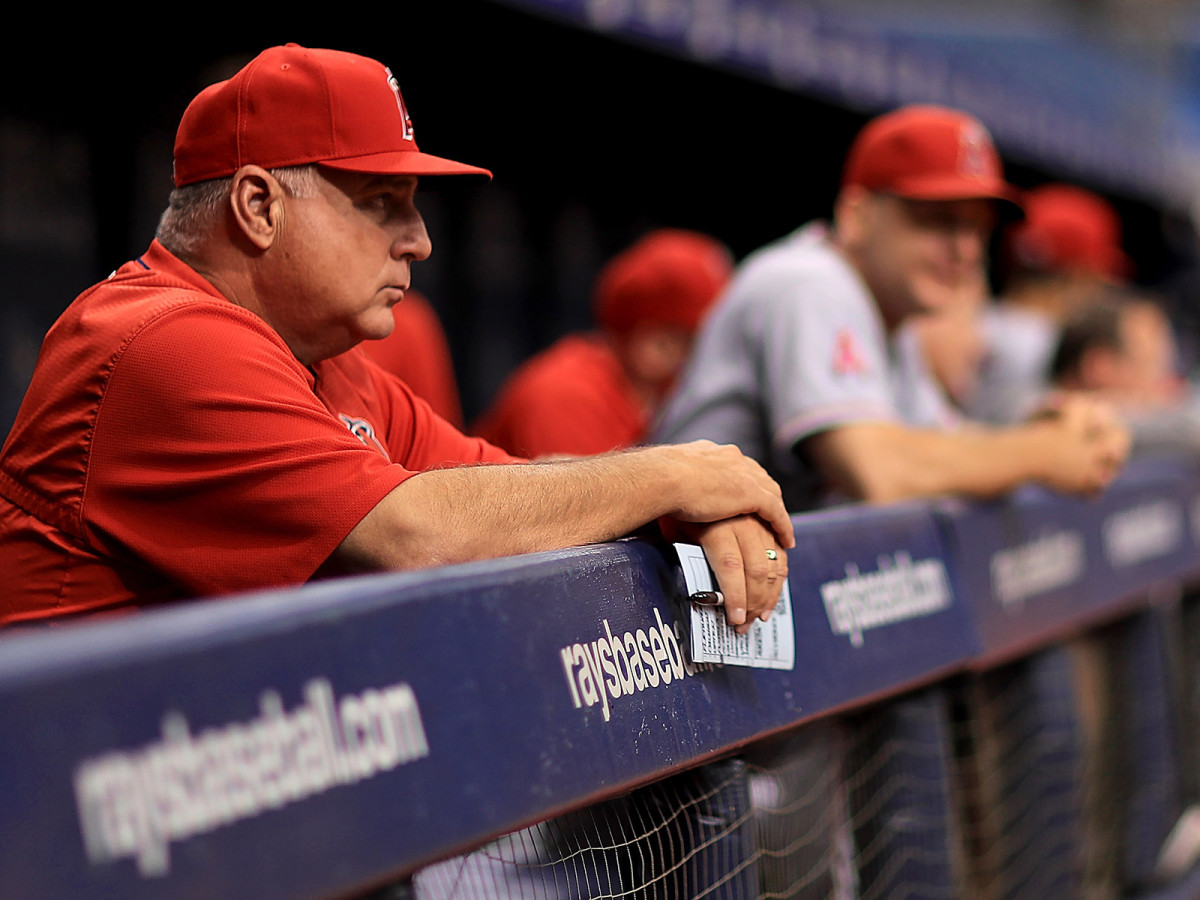
By Tom Verducci
The report from The Athletic that Mike Scioscia does not intend to return for a 20th season managing the Los Angeles Angels is not surprising. He is in the last year of a 10-year contract—allowing a manager to work as a lame duck is always a bad sign—he hasn’t won a playoff game in nine years, and there is a tidal wave sweeping baseball of young general managers wanting young, compliant managers not with authority or experience but with “relatable” personalities and first-language fluency in analytics.
On Sunday, Scioscia called the report “poppycock,” saying he has made no decision about 2019 and is abiding by a meeting with GM Billy Eppler after last season in which they agreed to wait until after this season to discuss his status.
Scioscia ranks 20th all-time in games managed (3,029) and by the end of the season will pass Tommy Lasorda for 19th. He ranks 18th in most wins (1,625), but among the top 20 he has the fourth-worst postseason winning percentage (.438), behind Gene Mauch (.417), Dusty Baker (.418) and Bill McKechnie (.364).
Scioscia is one of only 16 men to win 1,625 games and a World Series—and he and Walter Alston of the Dodgers are the only managers to be so accomplished exclusively with one team.
Scioscia’s extended run with one team is the most remarkable aspect of his portfolio, which otherwise resembles those of Baker, Jim Leyland, and Lou Piniella. It’s not that the game has passed him by. Indeed, Scioscia has a keen baseball mind and still brings energy and edge each day. But in today’s game, experience in the dugout has been devalued now that general managers have wrested control from managers. Also, in the era of two wild cards, you can’t be expected to keep your job if you keep failing to win playoff games.
Angels Manager Mike Scioscia Denies Rumors of Him Stepping Down
Scioscia has not won a playoff game since 2009, which includes the entire career of the best player in baseball, Mike Trout. The Angels are one of only seven teams that have not won a playoff game in that span, and the only one to do so with the same manager. (The other six teams with such a drought—the Twins, White Sox, Mariners, Marlins, Rockies and Padres—have burned through 23 managers combined.)
Under Eppler, 42, who was two years out of getting his college degree in finance when Scioscia began managing, the Angels are likely to join the Yankees, Red Sox, Rays, Blue Jays, Twins, Mariners, Rangers, Phillies, Braves, Nationals, Mets, Brewers, Cardinals, Diamondbacks, Dodgers and Padres—more than half the teams in baseball—by hiring somebody who has never managed before in the big leagues. A former assistant GM in New York, Eppler might consider some of the same fresh names the Yankees considered before hiring Aaron Boone: Eric Chavez, Josh Paul and Chris Woodward, for example. But if Eppler wanted to go off script, he could hire a guy who actually has managed before: Brad Ausmus, one of his special assistants who was fired by Detroit.
Ausmus is a good example of the way baseball used to work: managers are better the second time around, when they can learn from their mistakes. Twelve straight World Series have been won by a manager on at least his second job. Ausmus figures to be much better than when he was in Detroit, when he grew uptight and also didn’t have access to many of the game’s technologies and statistical analysts that have become common. Indeed, one of the Ausmus’s friends in the managerial business told him after he was fired, “Considering how much more [information] other teams have, you haven’t really managed in the big leagues yet.”
DETERMINING AN X-FACTOR FOR EACH NATIONAL LEAGUE CONTENDER
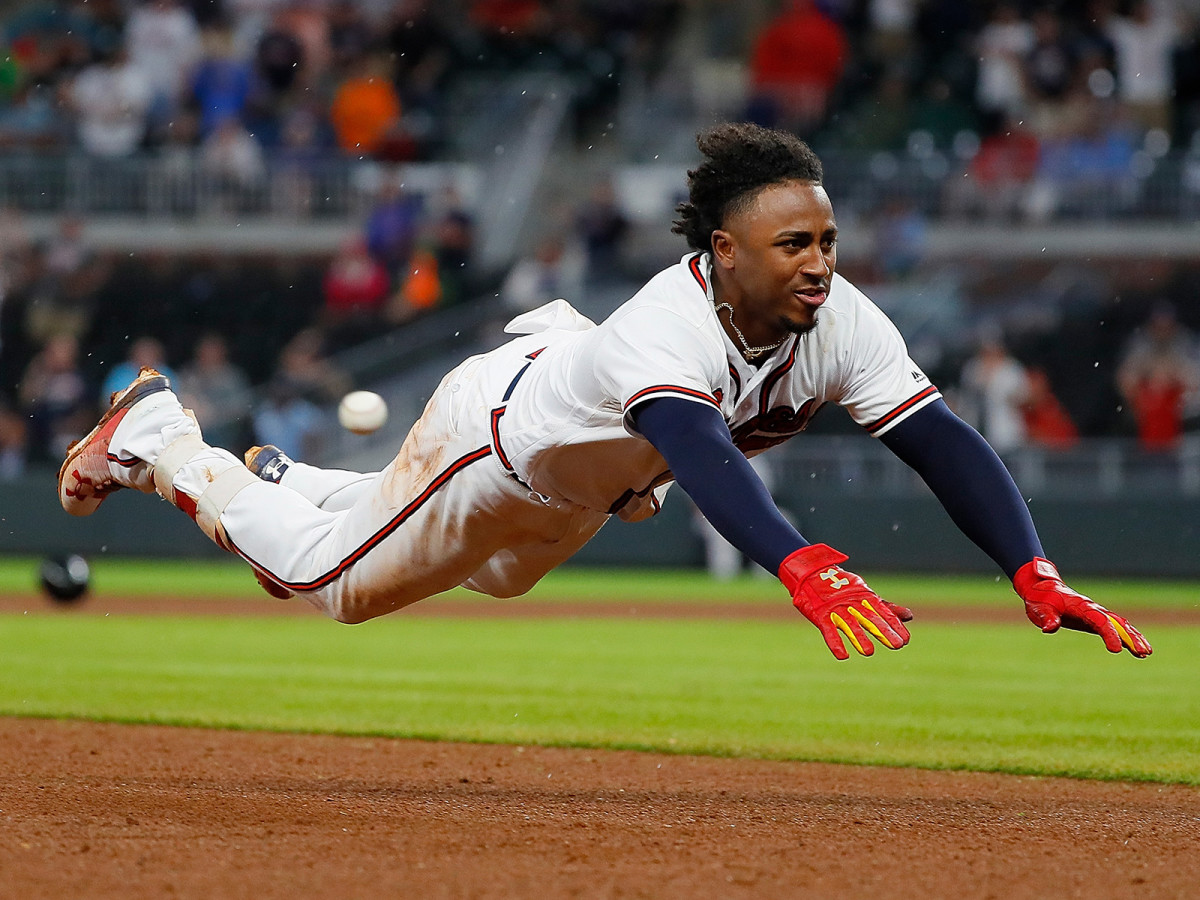
By Michael Beller
The National League will likely deliver a handful of excellent playoff races the next two months. The division leaders—the Cubs, Phillies, Diamondbacks and Dodgers (tied)—are all two games or fewer clear of the next best team. It’s entirely possible that all five postseason berths in the NL are still up for grabs in the final week of the season. With that in mind, let’s consider one key player for each contender. Sorry Pirates, Cardinals and Nationals. You’re all still alive, but we had to cut this off somewhere.
Teams are presented in order of record on August 6.
Chicago Cubs: Yu Darvish
Chicago's rotation has been the team’s weakest point, and much of that owes to Darvish spending more than half the season on the DL. He hasn’t started a game since May 20 as he continues to work his way back from triceps and back injuries. There finally seems to be some hope as he could rejoin the rotation late this month. If the Cubs are going to make their fourth straight NLCS, and get back to the World Series for the second time in three years, they’ll need Darvish to be the dominant ace he can be.
Milwaukee Brewers: Christian Yelich
By bringing in Mike Moustakas and Jonathan Schoop and not acquiring a pitcher before the trade deadline, the Brewers bet big on their offense and bullpen. If they’re going to mash their way to a deep October run, they’ll need someone to act as the nucleus of the offense. Yelich is best equipped to be that hitter. He has placed himself firmly in the NL MVP race in his debut Milwaukee season, hitting .326/.387/.542 with 17 homers, 25 doubles and 59 RBIs. Great offenses invariably depend on multiple hitters throughout the season, but come October the best needs to rise to the top. For the Brewers, that’s Yelich.
Philadelphia Phillies: Nick Pivetta/Vince Velasquez
The Phillies have risen to the top of the NL East on the strength of a rotation that ranks seventh in ERA and third in fWAR. Aaron Nola has turned into a legitimate ace, and Jake Arrieta, while no longer at the height of his powers, is a playoff-tested starter who has pitched deep into October. The Phillies need Pivetta and/or Velasquez to be at or near their best to get back to the postseason for the first time since 2011. Should they get there, all eyes will be on Pivetta and Velasquez in October to round out what could be the NL’s best postseason rotation.
CC Sabathia's Magical Post-Trade Run With the Brewers Remembered As One of the Best Ever
Atlanta Braves: Ozzie Albies
When the Braves surged out to a 16-11 March/April, they did it behind Albies. He hit .293/.341/.647 the first month of the season. He was always going to slow from that pace, but his .276/.305/.452 slash line since then has been a bit of a disappointment, especially the OBP number. If he can find a level somewhere between April and the rest of the season, he can be the gear atop the Atlanta offense that kickstarts the entire machine. Albies has the ability to give the Braves an additional elite producer they’ll need to turn this competitive season into a postseason return.
Arizona Diamondbacks: Robbie Ray
On paper, there might be one or two teams in the current NL postseason field that could hope to match a top three of Zack Greinke, Patrick Corbin and Robbie Ray. In reality, Ray has not lived up to his end of the bargain this season. The lefty has a 5.05 ERA and 1.39 WHIP in 66 innings, falling well short of expectations after a breakout 2017 campaign. If he can right the ship, the Diamondbacks could finally unseat the Dodgers atop the NL West and be a dangerous team on the NL side of the playoff bracket.
Los Angeles Dodgers: Clayton Kershaw
There’s no reason to try to get cute here. Kershaw is the key X-factor in the entire National League. He has been great, but not quite his dominant self, since returning from his second DL stint, pitching to a 2.33 ERA and 1.01 WHIP with 45 strikeouts in 46 1/3 innings. There aren’t many pitchers in MLB history for whom an eight-start stretch with those numbers could be called “not quite dominant,” but Kershaw is one of them. He's starting to hit his stride, though, notching six straight quality starts and shutting down Milwaukee and Atlanta in his last three starts. He’s one of the few players who could single-handedly turn his team into the favorite for the pennant.
Colorado Rockies: Jon Gray
Gray has been maddeningly inconsistent this season, a reality that forced a short demotion to Triple-A Albuquerque. He’s finally turning it around, though, throwing at least seven innings while allowing two runs or fewer in four of his last five starts. One of those starts came against the Astros at Coors Field, showing just what Gray can be when he’s at the top of his game. If he can be there the rest of the season, the Rockies just may crash the postseason party. Honorable mention here to Nolan Arenado, who’s having his best career season and should be considered one of the favorites for the NL MVP.
THE CURIOUS CASE OF CHRIS ARCHER, THE PIRATES AND SINKERS
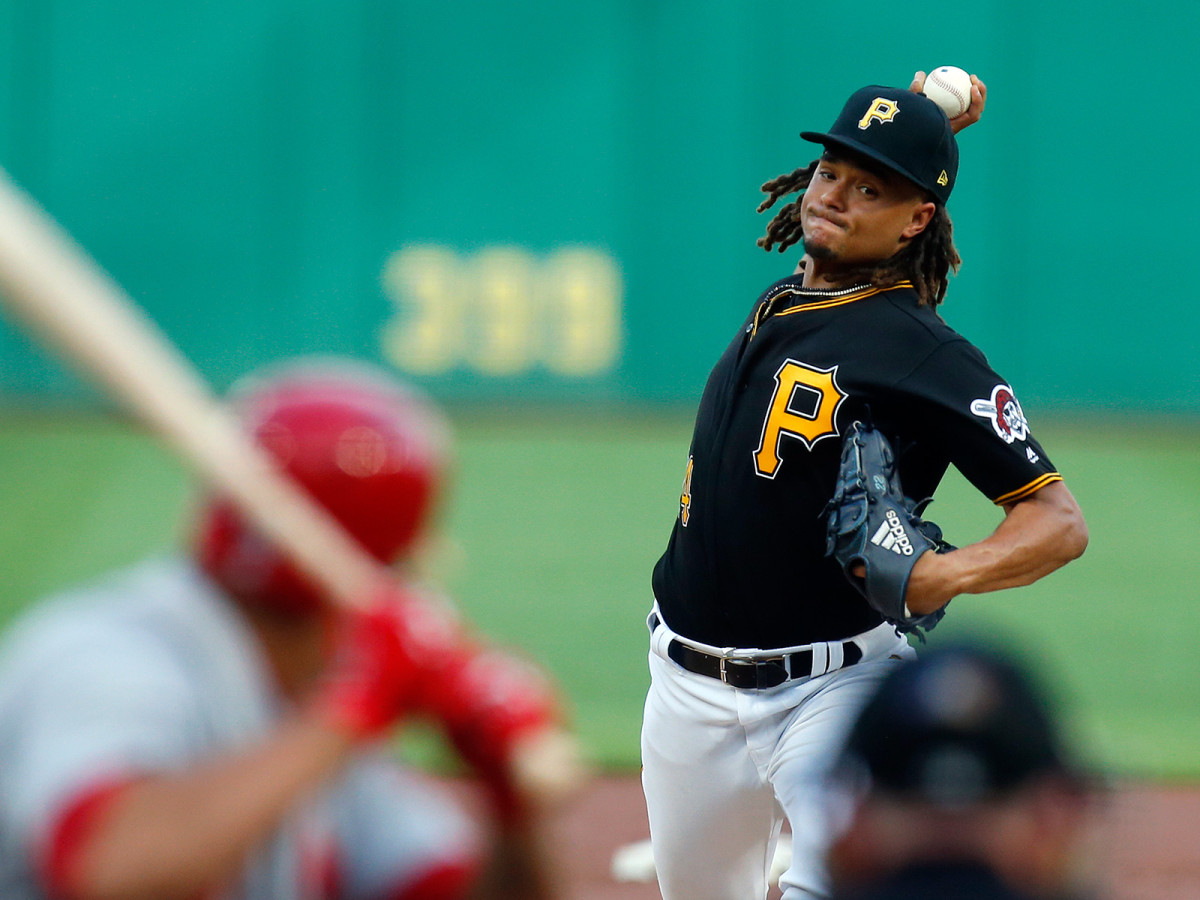
By Emma Baccellieri
While Chris Archer’s first start as a Pittsburgh Pirate didn’t quite match the hype—five runs, four earned, in 4 1/3 innings—it did reveal a curious change in his approach. In that one game, Archer threw his sinker more than he had in all his outings from the last two seasons combined. From Brooks Baseball, here’s a chart with the jump in sinker use from his single start this month circled in green:
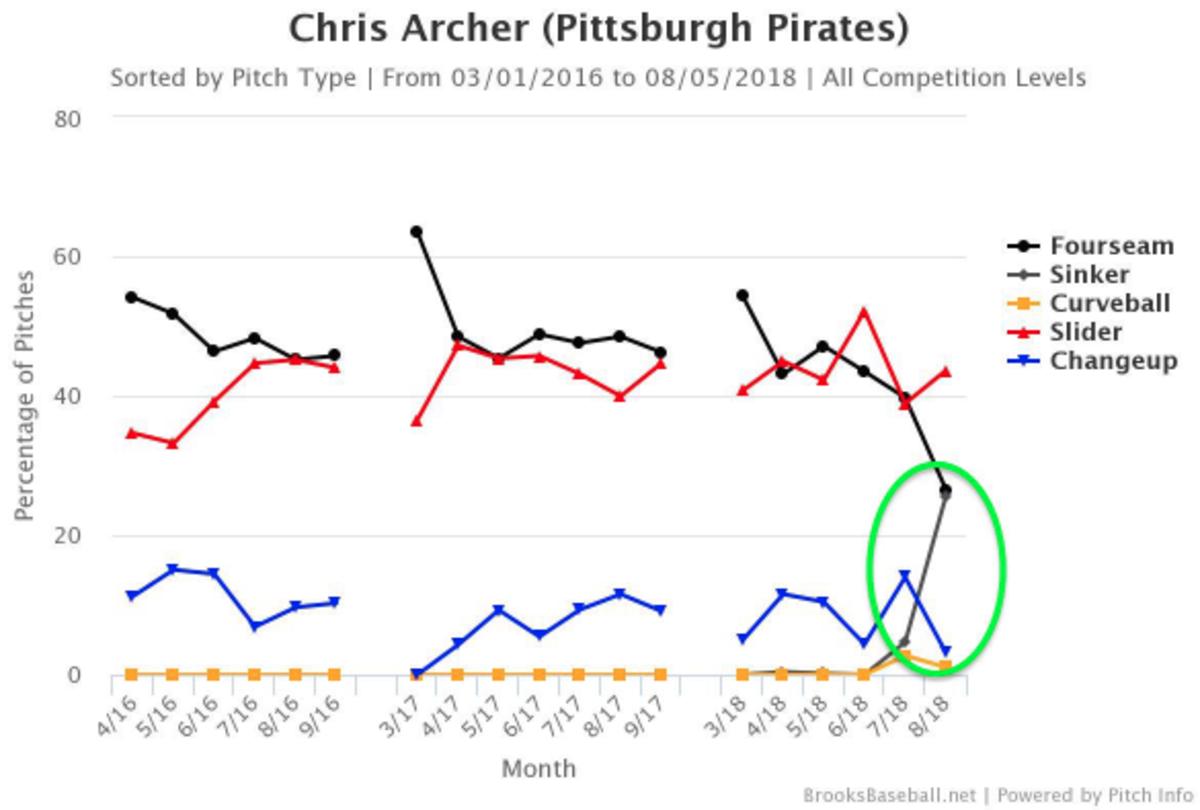
It’s only one start, but even so—that’s a big jump! Prior to Friday’s start, Archer’s sinker had accounted for 1% of his total pitches. On Friday, that number was 26%. As R.J. Anderson wrote at CBS Sports yesterday, it’s not the result of a pitch classification error: Archer was most definitely locating his fastball very differently in this one game than he had been previously. It’s probably not surprising that Archer would make this change after being traded to the Pirates. The team’s sinker-heavy approach made headlines as they ended two decades of playoff drought in 2013, and the role that pitching coach Ray Searage’s strategy played in that success was a central part of Travis Sawchik’s book about the team, Big Data Baseball. What might be surprising, though, is just how much that Pittsburgh has shifted away from this approach in recent years.
In every season from 2013 to 2016, Pittsburgh led baseball in proportion of sinkers and two-seam fastballs thrown. (The terms are often functionally interchangeable, but there can be some differences between the two.) In 2017 and 2018, however, that hasn’t been the case:
Season | Pirates' Two-Seamer/Sinker Use | League Average Two-Seamer/Sinker Use |
|---|---|---|
2013 | 36.2% (1st) | 22.2% |
2014 | 41.0% (1st) | 22.3% |
2015 | 37.5% (1st) | 21.2% |
2016 | 31.6% (1st) | 20.2% |
2017 | 25.7% (5th) | 20.1% |
2018 | 21.1% (12th) | 19.4% |
The Pirates rode the sinker to success, but they’ve lately been backing away from it. So does that reflect a difference in team strategy, or simply different pitching by a different group of pitchers? It’s true that this is a very different group of pitchers. Of the 23 pitchers who made an appearance for the 2014 Pirates, none have pitched for the 2018 Pirates. (Only one is still in the organization, Casey Sadler, who’s currently on the 40-man roster but hasn’t made a major-league appearance in three years now.)
But there’s more to this trend than just roster turnover. Take a look at some of the pitchers who made up that rotation in 2014, and where they are and what they’re throwing now. Sure, there’s Francisco Liriano, who always relied on his sinker and has continued to do so after leaving Pittsburgh. But there’s also someone like Charlie Morton. In his rookie year in Atlanta in 2008, sinkers made up 30% of his pitches. He was traded to Pittsburgh in 2009, and Searage became the team’s pitching coach in 2010. Morton began to use his sinker more and more, and by 2015, the righty was throwing it 62% of the time. That dropped when he signed with the Houston Astros two winters ago, and the sinker now makes up just 26% of Morton’s pitches. Or look at Gerrit Cole, whose sinker accounted for about 18% of his pitches when he was in Pittsburgh. Now in Houston with Morton, he’s thrown it sparingly this season, less than 4% of the time. Or even Jeff Locke, whose sinker made up more than 60% of his pitches when he was in Pittsburgh in 2014 and less than 40% of them when he was in Miami in 2017.
In other words—Searage wasn’t working with a group of pitchers who seemed to be uniquely or especially suited to sinkers. Throwing down in the zone was a strategy that the team embraced with just about everyone in the rotation at the time, and most of those pitchers have moved away from that now that they’re elsewhere. The Pirates’ current pitchers, obviously, have moved away from the strategy, too. There are four members of Pittsburgh’s 2018 rotation who have been with the team since 2016. Here’s how their sinker use has changed in that time:
| 2016 Sinker % | 2017 Sinker % | 2018 Sinker % |
|---|---|---|---|
Jameson Taillon | 38.4% | 35.1% | 23.2% |
Ivan Nova | 51.5% | 39.5% | 35.1% |
Trevor Williams | 25.5% | 22.4% | 20.7% |
Chad Kuhl | 61.4% | 63.3% | 46.2% |
Maybe Archer’s embrace of the sinker in his first start as a Pirate was a one-start quirk, and maybe it’s the beginning of a legitimate shift in his approach. But if it’s the latter, it’ll make him stand out in this rotation—if not quite as a relic of a few years past, then at least as a reminder of one.
WHAT'S ON TAP: FIRST-PLACE CLUBS CLASH IN THE DESERT
By Michael Beller
Hitter to Watch: Khris Davis, A’s
Davis is on an absolute tear over the last two weeks, hitting .302/.371/.830 with nine homers and 21 RBIs in 62 plate appearances. The A’s have overtaken the Mariners for the second wild card spot in the AL, leading their division mates by 2 1/2 games. They’re doing it behind one of the league’s best offenses, and Davis is right at the center of it all, figuratively at literally. When he was on the DL at the end of May, the team went 3-6 and averaged 1.67 runs per game. With him hitting cleanup, they’re scoring 5.02 runs per game.
Pitcher to Watch: Zack Greinke, Diamondbacks
Greinke is putting together a fine season that is seemingly flying under the radar. The 34-year-old owns a 2.96 ERA, 1.04 WHIP and 148 strikeouts in 142 2/3 innings, easily his best year since joining the Diamondbacks in 2016. He has been lights-out in his last four turns, pitching to a 1.26 ERA and 0.63 WHIP with 31 strikeouts against two walks in 28 2/3 innings. He takes the ball once this week, starting Tuesday in the middle of a huge three-game series with the Phillies. Speaking of that series…
Series to Watch: Phillies at Diamondbacks, Monday through Wednesday
No first-place team in the NL has a lead larger than two games over its nearest competitor, which almost certainly means were getting at least one great race in the senior circuit over the next two months. Two of those teams, the Phillies and Diamondbacks, get together for a three-game set in Phoenix to start the week.
Not only are these games huge in terms of these two holding onto their leads in the NL East and NL West, respectively, but they could also factor into the wild card race. The Phillies enter the series at 63-48, two games ahead of the Diamondbacks in the overall standings. The Phillies will send Jake Arrieta, Nick Pivetta and Vince Velasquez to the mound, while the Diamondbacks counter with Zack Godley, Greinke and Patrick Corbin.
FROM THE VAULT: LOOKING BACK ON THE 1994 STRIKE
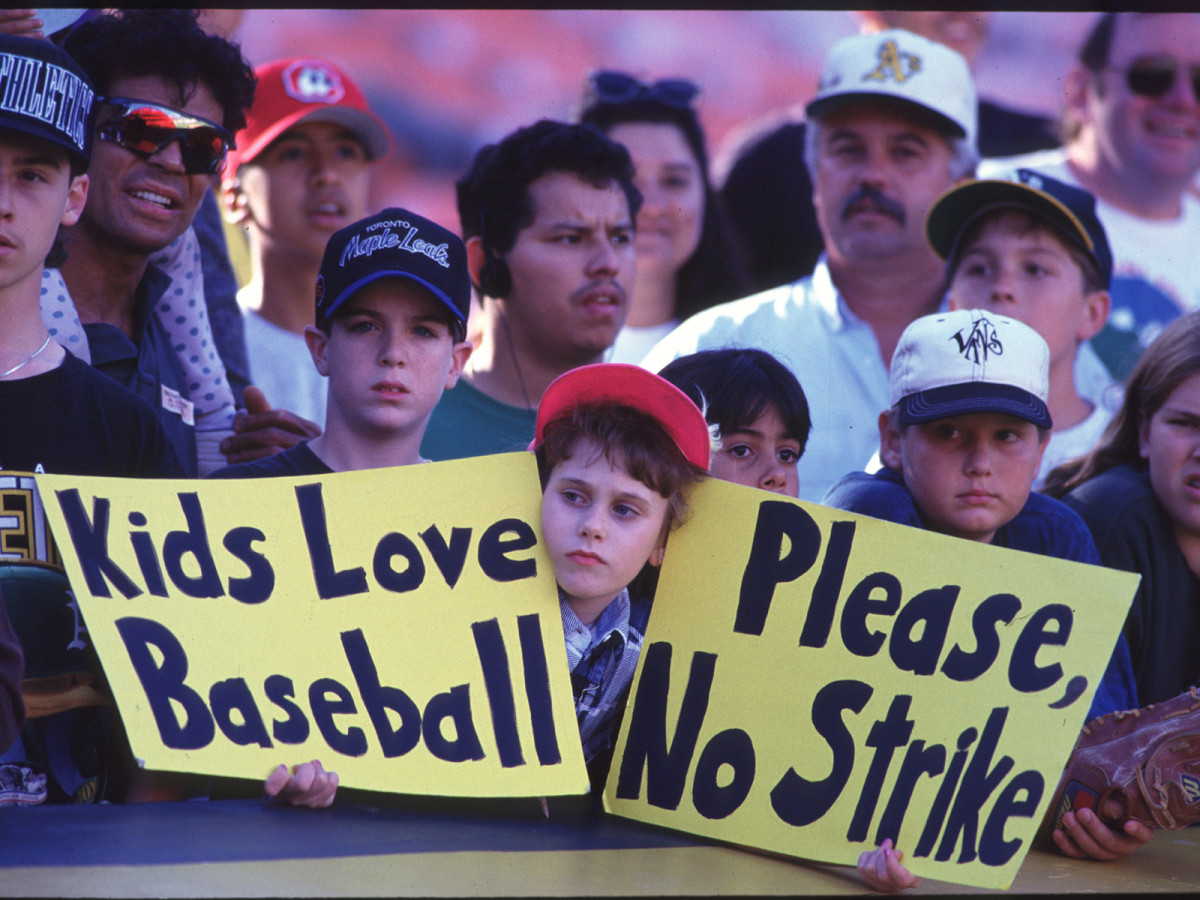
By Connor Grossman
It's been nearly a quarter century since Major League Baseball last had a work stoppage. The topic is unfortunately relevant again after months of unproductive discourse, some of that in public, between the MLB Players Association and team owners. We'll place that aside momentarily and remind you that the 1994 MLB players' strike began on Aug. 12, 1994. That'll be 24 years ago on Sunday.
At the time players believed they would reach an agreement with owners to resume play in time for September's stretch run, not to mention the postseason. SI didn't know World Series would eventually be cancelled when the following piece ran on Aug. 22, 1994, but we filled in the blanks for the rest of the season just in case. Come for Tony Gwynn's quest to hit .400, stay for the Red Sox-Cubs Fall Classic.
Enjoy the excerpt below and find Richard Hoffer's entire piece here.
Oct. 2: Almost certainly the greatest day in baseball history, this final day of the season. The three networks cut away from the O.J. Simpson trial, which features the fourth day of cross-examination of the Nick at Nite man, to check in on four divisional races as well as Tony Gwynn's shot at hitting .400 and Matt Williams's ever-diminishing chances of hitting 62 home runs.
In the American League, Boston blows out New York 16-3 for the Eastern Division title. Roger Clemens (18-7) gets the win; the Yankees are listless and dispirited. The Boss is furious at his team's conspicuous lack of effort, as well as at the idea that he has to share TV revenue with "rinky-dink clubs like Seattle." Cleveland completes a historic season with a sweep of Baltimore. Chicago settles behind the Tribe but gets the wild-card spot. Texas loses in Minnesota, but nobody cares. Chuck Knoblauch, however, is stymied in his bid for the doubles record; he is ejected when he tries to take two bases after being hit by a pitch. Ken Griffey Jr. hits his 60th homer.
In the National League, Tony Gwynn refuses to sit and preserve his .400 average. Through the ninth inning against the Colorado Rockies he is 1 for 3, his average dipping into the .390's. However, he rips a single off the glove of diving shortstop Walt Weiss in the 10th, and his average goes to .401. Matt Williams, whose teammates are now calling him Sasquatch, struggles in the Giants' final game, in Los Angeles. In his last at bat he homers, but that gives him only 60. The Dodgers rally to win 4-2, tying the Giants for first in the West; a playoff game is required. With a win in Pittsburgh, the Cubs, behind Ryne Sandberg's clutch hitting, climax a wild seven-week comeback from worst to first in the Central. Atlanta gets the wild-card spot.
